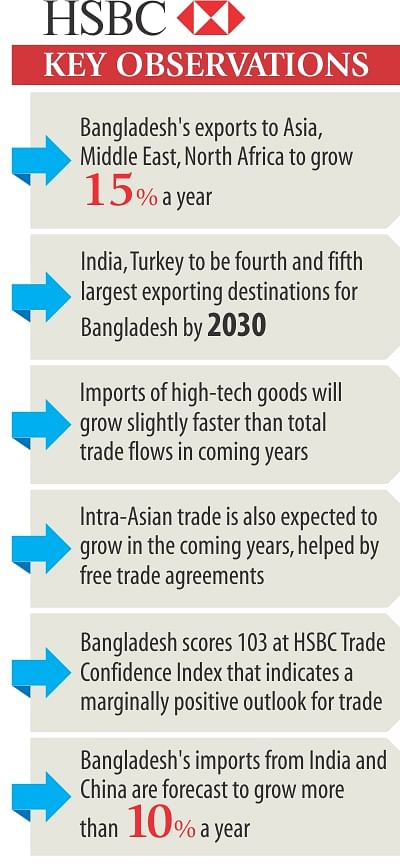High hopes for exports

Bangladesh's exports to Asia, Middle East and North Africa will grow 15 percent a year over the three years to 2016 on the back of stronger global economic growth, according to a recent study by a foreign bank.
The country will see a major shift on its export destinations over the next 20 years, HSBC said in its Global Connections Report.
Bangladesh was also included in the HSBC Trade Confidence Index (TCI) for the first time, and scored 103. This indicates a marginally positive outlook for trade, slightly below China, India, Indonesia and Vietnam.
Although the US and Germany will remain Bangladesh's largest trading partners until 2030, rising incomes across emerging markets will help drive strong trade flows from Bangladesh to these markets, the study said.
By 2030, India and Turkey will overtake France and Canada, which were Bangladesh's fourth and fifth largest export destinations in 2012.
Textiles, clothing and wood manufacturing will contribute around three-quarters of Bangladesh's export growth during 2017-2030, reflecting the country's expertise and low labour costs, it said.
Oxford Economics, a leader in global forecasting and quantitative analysis, and TNS, another London-based research firm, prepared the report for HSBC based on the bank's own analysis and forecasts of 180 economies.
Forecast data were modelled by Oxford Economics, while Trade Confidence Index was conducted by TNS on behalf of the bank in a total of 23 markets.
The survey comprises six months' views of 5,550 exporters, importers and traders from small and mid-market enterprises and the field work was conducted between November and December last year.
Conditions are gradually improving for Bangladeshi exporters. More than 35 percent of the businesses surveyed expect an improvement in trade volumes over the next six months.
More than half of the respondents to the TCI survey cited Asia as the most promising region for trade, while around 10 percent cited North America as the most promising region.
Europe was chosen by a third of
the survey respondents, reflecting Eurozone's return to growth and the strength of European demand for Bangladeshi clothing and apparel, the study said.
Bangladesh's exports grew to $27.01 billion in fiscal 2013, the highest in the country's history, up around 11 percent from the previous year, according to Export Promotion Bureau.
Shipments rose around 14 percent year-on-year to $19.82 billion during July-February of the current fiscal year.
The HSBC study said Bangladesh will focus more on the import of high-tech goods, both finished products for the rapidly growing consumer market and inputs into the global supply chain, in coming years.
In 2012, high-tech goods accounted for 7 percent of Bangladesh's imports. Imports of such items are expected to grow slightly faster than total trade flows in the years to come, it said.
Industrial machinery and transport equipment are expected to account for more than 25 percent of total goods imports in 2030, indicating Bangladesh's substantial infrastructure needs.
Japan was Bangladesh's largest import supplier last year, but by 2030 China and India will be more important sources. Bangladesh's imports from China and India are forecast to grow more than 10 percent a year during 2017-2030, according to the study.
Intra-Asian trade will also get a boost riding on free trade agreements, it said.
Bangladesh imported goods and services worth $33.57 billion in fiscal 2012-13, up by 0.80 percent from the previous year, according to the central bank.
The Eurozone is the largest buyer of Bangladeshi textiles, so stronger European growth this year should boost economic growth in Bangladesh despite the dampening effects of political unrest on domestic activities, it said.
In the long term, rising foreign direct investment inflows should support investment in Bangladesh. Growing household incomes should open up the market for consumer goods, including high-tech products.
Almost 30 percent of Bangladesh's population now lives in cities. The rapid pace of urbanisation has boosted education prospects, with almost 60 percent now literate, up from less than a third in 1980.
As only 6 percent of the population uses internet, according to the World Bank, there are opportunities for rapid expansion of trade in high-tech goods, the HSBC study said.
The currency of choice for trade is overwhelmingly the US dollar, identified by 96 percent of the respondents. As a result, currency volatility is a concern for a quarter of the respondents. Almost half are worried about rising interest rates.

 For all latest news, follow The Daily Star's Google News channel.
For all latest news, follow The Daily Star's Google News channel. 



Comments